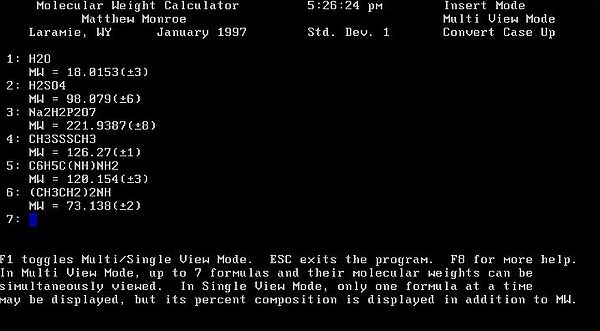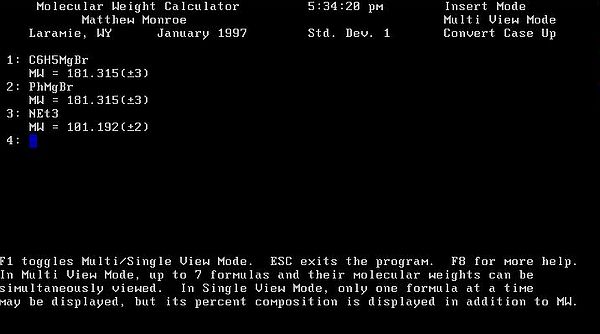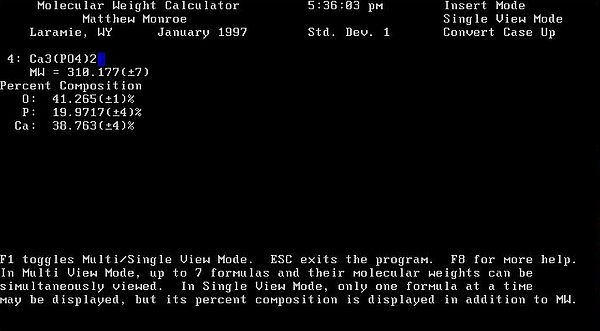Molecular Weight Calculator for DOS.
Molecular Weight Calculator for DOS is a freeware program, written in 1997 by Matthew Monroe, Washington State, USA. It may be used to calculate the molecular weight and the chemical composition of molecules. Here are some of the features of the program:
- Input of the molecules as you would write them on paper, in particular possibility to use parentheses; ex: (CH3)3CH2CH3.
- Possibility to use abbreviations for common compounds. Several such abbreviations are included with the program, and you can add your own ones; ex: Ph = phenyl group -> PhCl = phenylchloride
- The program also includes the 3-letter amino acids codes; ex: Val = valine.
- Hydrates or other addended compounds are allowed; ex: FeCl3-6H2O is iron(III) chloride hexahydrate.
- The program also recognizes isotopes; ex: ^13C means Carbon-13; C6H5^18OH is heavy-oxygen (Oxygen-18) phenol.
- Also included: Help text, calculator, percent solver...
The program runs fine on FreeDOS. I guess that it also works on other DOS distributions.
You can download the program from the author's website. The download is a ZIP archive, that fits
on a floppy diskette (easiest way to get the file on your DOS machine). To get the archive content onto the harddisk in the directory C:\MWT2, run the following
commands:
mkdir mwt2
a:
unzip -d c:\mwt2 mwt2_87.zip
The program executable is called mwt.exe. It starts in multi view mode, that allows to display 7 molecular weight calculations (in single view mode, there is only one calculation displayed, but you also get the chemical composition of the molecule, i.e. the percentage of the atoms, the molecule is made of). The screenshot below shows the calculations for water, sulfuric acid, disodium pyrophosphate, dimethyl trisulfide, benzamidine, and diethylamine.

|
The following screenshot shows the calculation of the molecular weight of phenylmagnesium bromide and triethylamine, using the included abbreviations "Ph" for phenyl, and "Et" for ethyl.

|
And the following screenshot shows the molecular weight and chemical composition of tricalcium phosphate. To display the chemical composition, you have to switch to single view mode. You toggle between the two viewing modes using the function key F1.

|
MWT2 includes 3 recognition modes: No recognition, normal recognition, and extended recognition. Whereas in normal recognition mode (active when the program starts), common abbreviations such as "Ph" and "Et" are recognized, you have to switch to the extended mode in order to recognize the amino acid codes. Toggling through the 3 modes is done using the function key F3. The screenshots below show how I calculated the molecular weight of the first ten amino acids of chain A of human insulin. On the left, normal recognition mode is active, and the usage of the amino acid codes generates an error. On the right, I have switched to extended mode, and the calculations are done.
![Molecular Weight Calculator for DOS: Proteins molecular weight calculation [1] Molecular Weight Calculator for DOS: Proteins molecular weight calculation [1]](./screenshots/mwt2d1.jpg)
|
![Molecular Weight Calculator for DOS: Proteins molecular weight calculation [2] Molecular Weight Calculator for DOS: Proteins molecular weight calculation [2]](./screenshots/mwt2d2.jpg)
|
If you like this page, please, support me and this website by signing my guestbook.